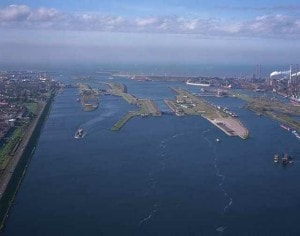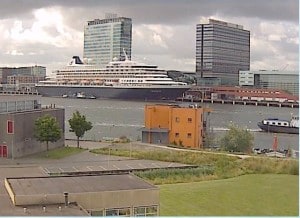As it is for everybody who is coming home, arriving in your own country is always something to look forward to. I just wish it would not take such a long time to get there. To get through to Amsterdam you have to pass the locks at IJmuiden and then do a slow 2 hour transit through the North Sea Canal to the passenger terminal. The latter is located right in the middle of Amsterdam and that makes up for a lot of the inconvenience it takes in getting there. Those who are really excited were of course all who were going home today and even if you were not living in the Netherlands, Schiphol airport offers some of the best connections with the rest of the world in comparison with any other major airport. I might be biased but I still think that Schiphol is the best airport in the world, starting with the toilets. For those who went home, we have a Dutch saying: “Kanaal koorts” or channel fever. The phrase comes from the old Trans Atlantic passenger liners, where the last night onboard was the evening when the ship sailed through the Dover Channel up to Rotterdam. Everybody was packing, excited, nervous (have I not forgotten anything) frantically running around saying good bye’s to everybody. Etc etc. My Dutch and British Officers, who were going home, were showing all the symptoms of a heavy attack of this fever.
We arrived at the early hour of 3 am at the pilot station while a near gale was blowing from the WNW. However as it was blowing in line with general line up of the dock, it pushed the ship into the locks without much of a problem. IJmuiden pilot station asks for an ETA starting about two days in advance, followed by an update every so many hours. Many more updates than other ports require. This has to do with the fact that the Ijmuiden locks have to be scheduled as economically as possible as they cause a delay in the traffic flow. As a cruise ship runs on the minute, we had the pilot on board at 02.58 in the morning and entered the locks waiting for us at 3.30 as planned. The lock master must have been quite happy with us. The Dutch pilot stayed all the way to the dock as there is no change over between sea and river pilotage here in Amsterdam. As we arrived at nearly slack water there was only about six inches of difference between the sea and the canal water height and hence the East door opened almost at the same time as the West (sea) door closed.
While in the locks the ship is kept in place with two lines forward and two lines aft and these lines are handled by specialized linesmen ashore, who throw a heaving line onto the ship instead of the ship throwing one ashore. As is usual they always get into arguments with the ships crew who want to use their own line. It is a bit of a standard part of the operation. We were out of the locks within 30 minutes and then sailed with a maximum of 7 knots through the North Sea channel towards the dock. Occasionally we had to slow down when passing a small marina in a side channel, as the water displacement of a large ship, sailing by too fast, can really suck a shallow marina dry. All around us the Rhine barges went hither and dither, going in and coming out of the various ports and docks along the canal.
 Air photo from unknown source on the internet
Air photo from unknown source on the internet
Although the official arrival time in Amsterdam was 07.00 I was docked by 06.30, as the earlier luggage offloading starts, the less change of a delay there is for the disembarkation of the guests. We had numerous school tours onboard today. HAL is beating the drum very hard to get new officers for Hotel, Engine and Deck to join the company, so the groups from Maritime and Hotel schools are taken for tours onboard. For the rest travel agents, journalists and other people who might further the cause of the company’s existence, were led around by guides. Then there was the regular number of repairmen, inspectors and office people attending the ship for 1000 and 1 reasons. To top things off, it was a major provisioning port for us, so everybody had their hands full, especially as the crew that stayed on also had to take over the regular work of those who were leaving. Those who were taking over, even when onboard on time could not work yet. (The latter is caused by the fact that every crew member has to go through a safety indoctrination meeting before any work is allowed. Which is something I whole heartedly applaud but it means that it delays the start of their work by a few hours)
 Prinsendam docked at Amsterdam on 19 June. Photo courtesy..?? came via a friend from a friend. Let me know the name and I will update the credit.
Prinsendam docked at Amsterdam on 19 June. Photo courtesy..?? came via a friend from a friend. Let me know the name and I will update the credit.
I dove into my bed for two hours in the afternoon, as the way out would be as long as the way in. However the weather on the way out was nice and sunny. We had only one shower (right during passenger boat drill) and the rest was nice blue skies. I was starting to feel very old during our trip back to sea. Nearly every ship that we met this time, greeted me as the pilot onboard had sometime in the past served under me as a junior officer during the years that I was chief officer. Holland America is loosing every few years quite a few of the senior navigators to Dutch Pilotage. If the wife starts talking about baby’s and she finds out that a sea pilot is home more frequently than a deep-sea sailor and the pay is better; then what can a man do. Not everybody is living the Holland America dream like I do.
On the way out, we shared the locks with another ship. This is not compulsory but it saves a lot of time as otherwise you have to wait for the ship ahead of you to go out and opposing ships to go in. Pilots leave that decision to the ships captain as there is the marginal chance of a collision when docking in the locks. I did not see much of an issue here, I knew that I would not create a collision myself and another ship can bump into you anywhere. You cannot control what the other one does anyway. The only important issue is to ensure that there is enough room in the locks between the two ships. So with 60 feet spare between the ship and 15 feet between the Prinsendam stern and the lock door, we went down our 8 inches, as it was low tide in the North Sea. Going in with another ship saved me at least 2 hours. By 21.00 we were back in open sea making our way north towards the river Elbe, where tomorrow morning at 07.00 we will pick up the pilot for the run upriver towards the Kieler Kanal. I was in bed by 22:30 after having cleaned out my computer from the ever accumulating emails.
The weather for the Kieler Kanal looks a bit unsettled. Dry weather with rain clouds, so depending of where you are it will either rain or it will be dry………………. So we will find out what we will get when we get it.

June 22, 2009 at 10:20 pm
Again many thanks for the new things I’m learning, Captain [only with time one can accumulate a wealth of knowledge and experience, no?]
I fully agree with you that Schiphol is THE best airport in the world no matter what others say. It has the best connection times because of its clever lay-out, it was the first one in the world that had the moveable passenger bridges, and I believe you with regard to the toilets.
June 22, 2009 at 11:07 pm
Your post about being in Amsterdam is one of your very best….and that is saying a lot! Thanks so much.
June 23, 2009 at 5:38 am
Luchthaven Schiphol/Schiphol Airport; none better! – The wives love the shopping at Schiphol Plaza also plus picking up a satetje at one of the restauarant! Thanks for the great entry today Capt. Coming home to A’dam is always special!
June 29, 2009 at 8:31 pm
[Appendix ..] ~ “I was starting to feel very old” ~
In case this has not been a subject for personal research, Captain; aging, [getting sickly], and eventually dying is not normal 🙂 Modern technology has proven the deterioration of telemores, RNA and DNA should theoretically not happen. Scientists are guaranteed working hard to restore the mechanisms of it all. What the vast majority fails to understand is that the reason behind has always been a moral issue and, therefore, needs to be solved morally . . .